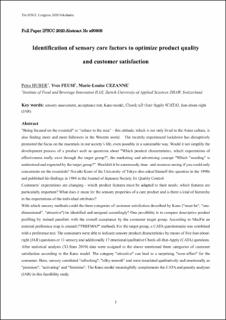Bitte benutzen Sie diese Kennung, um auf die Ressource zu verweisen:
https://doi.org/10.21256/zhaw-27949| Publikationstyp: | Konferenz: Paper |
| Art der Begutachtung: | Peer review (Publikation) |
| Titel: | Identification of sensory core factors to optimize product quality and customer satisfaction |
| Autor/-in: | Huber, Petra Feusi, Yves Cezanne, Marie-Louise |
| et. al: | No |
| DOI: | 10.21256/zhaw-27949 |
| Angaben zur Konferenz: | 31st IFSCC Congress, Yokohama, Japan, 20-23 October 2020 |
| Erscheinungsdatum: | 20-Okt-2020 |
| Verlag / Hrsg. Institution: | Society of Cosmetic Chemists of Japan (SCCJ) |
| Verlag / Hrsg. Institution: | Yokohama |
| Sprache: | Englisch |
| Schlagwörter: | Sensory assessment; Acceptance test; Kano model; Check-all-that-apply (CATA); Just-about-right (JAR) |
| Fachgebiet (DDC): | 660: Technische Chemie |
| Zusammenfassung: | "Being focused on the essential" or "reduce to the max" - this attitude, which is not only lived in the Asian culture, is also finding more and more followers in the Western world. The recently experienced lockdown has disruptively promoted the focus on the essentials in our society’s life, even possibly in a sustainable way. Would it not simplify the development process of a product such as questions about "Which product characteristics, which expectations of effectiveness really exist through the target group?", the marketing and advertising concept "Which "wording" is understood and expected by the target group?”. Wouldn't it be enormously time- and resource-saving if you could only concentrate on the essentials? Noriaki Kano of the University of Tokyo also asked himself this question in the 1990s and published his findings in 1984 in the Journal of Japanese Society for Quality Control. Customers’ expectations are changing - which product features must be adapted to their needs; which features are particularly important? What does it mean for the sensory properties of a care product and is there a kind of hierarchy in the expectations of the individual attributes? With which sensory methods could the three categories of customer satisfaction described by Kano ("must-be", "one-dimensional", "attractive") be identified and assigned accordingly? One possibility is to compare descriptive product profiling by trained panelists with the overall acceptance by the consumer target group. According to MacFie an external preference map is created ("PREFMAP" method). For the target group, a CATA questionnaire was combined with a preference test. The consumers were able to indicate sensory product characteristics by means of five Just-about-right (JAR) questions or 11 sensory and additionally 17 emotional/qualitative Check-all-that-Apply (CATA) questions. After statistical analysis (XLStats 2019) data were assigned to the above mentioned three categories of customer satisfaction according to the Kano model. The category "attractive" can lead to a surprising "wow-effect" for the consumer. Here, sensory correlated "refreshing", "silky-smooth" and were translated qualitatively and emotionally as "premium", "activating" and "feminine". The Kano model meaningfully complements the CATA and penalty analyses (JAR) in this feasibility study. |
| URI: | https://digitalcollection.zhaw.ch/handle/11475/27949 |
| Volltext Version: | Publizierte Version |
| Lizenz (gemäss Verlagsvertrag): | Lizenz gemäss Verlagsvertrag |
| Departement: | Life Sciences und Facility Management |
| Organisationseinheit: | Institut für Lebensmittel- und Getränkeinnovation (ILGI) |
| Enthalten in den Sammlungen: | Publikationen Life Sciences und Facility Management |
Dateien zu dieser Ressource:
| Datei | Beschreibung | Größe | Format | |
|---|---|---|---|---|
| 2020_Huber-etal_Identification-of-sensory-core-factors-to-optimize-product-quality_IFSCC.pdf | 422.8 kB | Adobe PDF |  Öffnen/Anzeigen |
Zur Langanzeige
Huber, P., Feusi, Y., & Cezanne, M.-L. (2020, October 20). Identification of sensory core factors to optimize product quality and customer satisfaction. 31st IFSCC Congress, Yokohama, Japan, 20-23 October 2020. https://doi.org/10.21256/zhaw-27949
Huber, P., Feusi, Y. and Cezanne, M.-L. (2020) ‘Identification of sensory core factors to optimize product quality and customer satisfaction’, in 31st IFSCC Congress, Yokohama, Japan, 20-23 October 2020. Yokohama: Society of Cosmetic Chemists of Japan (SCCJ). Available at: https://doi.org/10.21256/zhaw-27949.
P. Huber, Y. Feusi, and M.-L. Cezanne, “Identification of sensory core factors to optimize product quality and customer satisfaction,” in 31st IFSCC Congress, Yokohama, Japan, 20-23 October 2020, Oct. 2020. doi: 10.21256/zhaw-27949.
HUBER, Petra, Yves FEUSI und Marie-Louise CEZANNE, 2020. Identification of sensory core factors to optimize product quality and customer satisfaction. In: 31st IFSCC Congress, Yokohama, Japan, 20-23 October 2020. Conference paper. Yokohama: Society of Cosmetic Chemists of Japan (SCCJ). 20 Oktober 2020
Huber, Petra, Yves Feusi, and Marie-Louise Cezanne. 2020. “Identification of Sensory Core Factors to Optimize Product Quality and Customer Satisfaction.” Conference paper. In 31st IFSCC Congress, Yokohama, Japan, 20-23 October 2020. Yokohama: Society of Cosmetic Chemists of Japan (SCCJ). https://doi.org/10.21256/zhaw-27949.
Huber, Petra, et al. “Identification of Sensory Core Factors to Optimize Product Quality and Customer Satisfaction.” 31st IFSCC Congress, Yokohama, Japan, 20-23 October 2020, Society of Cosmetic Chemists of Japan (SCCJ), 2020, https://doi.org/10.21256/zhaw-27949.
Alle Ressourcen in diesem Repository sind urheberrechtlich geschützt, soweit nicht anderweitig angezeigt.